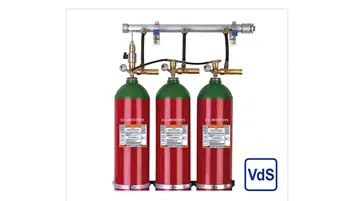Use of Inert Gas Fire Suppression Systems for Data Centers
Information Technology sector is a vital part of today's economy, providing businesses and individuals with access to critical information and services. As such, the protection of IT assets, such as data centers and server rooms, is of utmost importance. Data centers are critical infrastructure that store and process massive amounts of sensitive data for businesses and organizations around the world. Protecting these facilities from fire is of paramount importance, as a fire could result in the loss of data, downtime, and even potential harm to human life. Inert gas-based fire suppression systems offer a reliable and safe method for protecting data centers and server rooms from fire.
National Fire Protection Association's (NFPA) standard for clean agent fire suppression systems (NFPA 2001) includes guidelines for the use of inert gas-based systems, among other types of clean agents, in data centers and other critical facilities.
One of the key benefits of inert gas-based fire suppression systems is that they are safe for use in occupied spaces. As an alternate system to traditional fire suppression systems, which use water or other chemicals to extinguish fires, inert gas-based systems use a combination of gases, such as nitrogen, argon, and carbon dioxide, to suppress fires. These gases are non-toxic and do not leave any residue, making them safe for use in areas where people are present. Another advantage of inert gas-based fire suppression systems is that they are effective in suppressing fires quickly. The gases used in these systems are released rapidly, flooding the protected space, and reducing the oxygen level to a point where fires cannot be sustained.
This rapid suppression of fires can help prevent the spread of fire and minimize damage to IT assets, reducing downtime and ensuring business continuity. Inert gas-based fire suppression systems also offer the benefit of minimal clean-up after fire. Traditional fire suppression systems, such as those that use water or foam, can leave behind significant amounts of residue that can damage IT assets and require extensive clean-up. In contrast, inert gas-based systems do not leave any residue, eliminating the need for clean-up and minimizing the potential for damage to IT assets.
These systems use a combination of gases, such as nitrogen, argon, and carbon dioxide, to suppress fires without causing damage to the sensitive electronic equipment found in data centers. In this article, we will discuss the use of these systems in data centers and the international standards that govern their use. The use of inert gas-based fire suppression systems in data centers is governed by few international standards. The two most important standards are NFPA 2001 and ISO 14520. These standards provide guidelines for the design, installation, and maintenance of inert gas-based fire suppression systems, ensuring that they are effective and safe for use in data centers. NFPA 2001 is the standard for clean agent fire suppression systems. It provides guidelines for the design, installation, and maintenance of fire suppression systems that use clean agents, including inert gases. This standard ensures that the systems are effective in suppressing fires while minimizing damage to the equipment and the environment. ISO 14520 is the international standard for gaseous fire-extinguishing systems. It provides guidelines for the design, installation, and maintenance of fire suppression systems that use gaseous agents, including inert gases.
One should understand that it is very important to conduct a thorough fire hazard assessment, select the appropriate gas, ensure the room's integrity, design an effective piping network, consider the gas storage requirements, and design an effective alarm and control system. These factors are critical to ensuring the system's effectiveness in protecting the intended space from fire.
HD Fire Protect offers the HD Inertsys inert gas fire suppression system as one of its flagship products. The system is designed to quickly extinguish fires in areas where water-based fire suppression systems are not practical or effective. The HD Inertsys system uses a combination of argone, nitrogen and CO2 gases, which are stored in high-pressure cylinders (200/300 bar) and released through a network of piping and discharge nozzles. One of the key features of the HD Inertsys system is its ability to quickly suppress fires while minimizing damage to the protected space and its contents. The system works by reducing the oxygen concentration in the protected area to a level that cannot sustain combustion. The system is effective in suppressing fires involving Class A, B, and C combustibles, including electrical fires.
The HD Inertsys system is designed to be environmentally friendly, with zero ozone depletion potential and zero global warming potential. The system is also safe for use in occupied spaces and does not leave any residue or cause any damage to IT assets. The HD Inertsys system is available in various sizes and configurations, making it suitable for a wide range of applications, from small server rooms to large IT data centers and industrial facilities. The system is designed and manufactured with VdS Approval. Overall, the HD Inertsys inert gas fire suppression system is a reliable and effective solution for protecting critical assets from fire, and it has been widely adopted by various industries worldwide.
